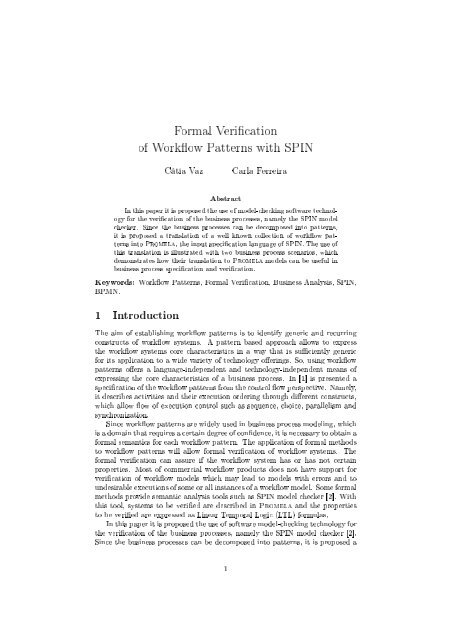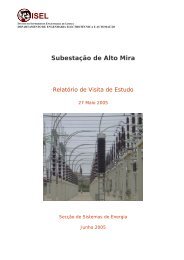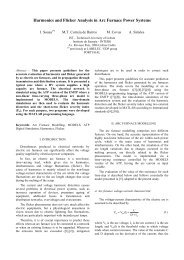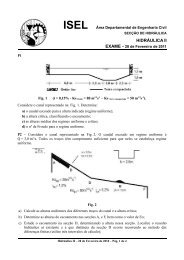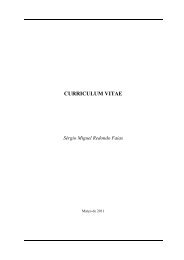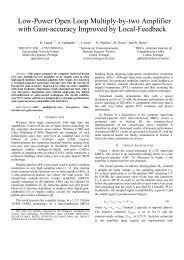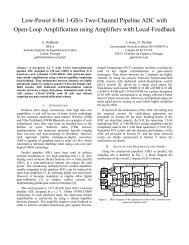Formal Verification of Workflow Patterns with SPIN
Formal Verification of Workflow Patterns with SPIN
Formal Verification of Workflow Patterns with SPIN
Create successful ePaper yourself
Turn your PDF publications into a flip-book with our unique Google optimized e-Paper software.
3 WORKFLOW PATTERNS TRANSLATION 3used in the description <strong>of</strong> control ow dependencies between activities and subprocessesin a workow process. Messages between processes will be represented,<strong>with</strong>out loss <strong>of</strong> generality, by integers in Promela.In the translation <strong>of</strong> these patterns into the Promela language, we willuse the following notation: q will represent a channel and msg the messagesent or received in channel q; qs will denote an array <strong>of</strong> channels <strong>of</strong> sizeqand msgs an array <strong>of</strong> messages <strong>of</strong> sizeq to be sent or received in each channelin the array qs. The variable choice will be used to denote, when needed,the index <strong>of</strong> the channel in the array qs in which will be sent the message.Also, choices is an array <strong>of</strong> indexes <strong>of</strong> chosen channels and activeqs is anarray indicating the active channels. In some patterns, it is also necessary toconsider the construct myRun that receives a process identication number idas a parameter and executes a new instance <strong>of</strong> the given process. The id <strong>of</strong>each process must be dened <strong>with</strong>in the model. The construct myRun has alsoan instance identication i, which is used for activity instances in the multipleinstance patterns. When there is no need to identify the new activity instanceexecuted by the process myRun, the instance identication parameter will be -1.The two workow constructs that are widely used in the workow patternsare the send and the receive. These constructs will be translated asinline send(q,msg){ q!msg;} and inline recv(q,msg){ q?msg;}, respectively.Note that variables are only declared in the scope <strong>of</strong> the proctypes thatuse these inline denitions.3.1 Basic Control Flow <strong>Patterns</strong>With respect to the Basic Control Flow <strong>Patterns</strong>, we will present the translation<strong>of</strong> the patterns Sequence, Parallel Split, Syncronization, ExclusiveChoice and Simple Merge.Sequence - An activity B in a workow process is enabled after the completion<strong>of</strong> a preceding activity A in the same process. The process A in Promela shoulduse the send denition and the process B should use the recv denition.chan q = [1] <strong>of</strong> {int};proctype A(){/* Do work. */send(q,1); /* To activate process B. */}proctype B(){int x;recv(q,x); /* Waiting token. *//* Do work. */}Note that the comments /* Do work. */ in the above processes should bereplaced by the details <strong>of</strong> each activity.Parallel Split - This pattern is dened as being a mechanism that will allowactivities to be performed concurrently, rather than serially. A single paththrough the process is split into two or more paths so that two or more activities
3 WORKFLOW PATTERNS TRANSLATION 4will start at the same time. This pattern is translated by the following inlinedenition, where each channel in the array qs is used to communicate <strong>with</strong> eachactivity.inline parallelSplit(qs, sizeq, msg){int n;n=0;atomic {do:: n qs[n]!msg[n]; n++;:: n>=sizeq -> break;od; }}The process in Promela which represents the activity that splits the processmust use the parallelSplit denition and the processes which represent theactivities to be initiated must use the recv denition.Synchronization - The Synchronization pattern combines the paths that weregenerated by the Parallel Split pattern. The nal set <strong>of</strong> activities <strong>with</strong>inthe ows must be completed before the process can continue. This pattern istranslated to the following inline denition.inline synchronization(qs, sizeq, msgs){int n, count;n=0; count=0;/* MAXARRAYSIZE: The capacity <strong>of</strong> the arrays defined in the file* which contains the translations <strong>of</strong> the workflow patterns */int aux[MAXARRAYSIZE];do::n aux[n]=0; n++;::n==sizeq -> n=0; break;od;skip;S:if::((aux[n]==0) && (len(q[n]) > 0) && countaux[n]=1; q[n]?msg[n]; count++::count>=sizeq -> goto E::else -> skip;fi;n++;if::n==sizeq -> n=0; timeout;::n skip;fi;goto S;E: skip;}The process in Promela that receives the input branches must use the abovedenition and the processes to be syncronized must use the send denition. It
3 WORKFLOW PATTERNS TRANSLATION 5is denoted by aux an auxiliary array <strong>of</strong> size sizeq to distinguish between theactivities already completed from the others. After nishing, each activity sendsa message through a channel in the array qs to report it (e.g. if the activity thatcomunicates through channel qs[n] is nished, it will send a message throughthis channel reporting that). In this pattern translation, all the channels inthe array qs are transverse to see if there is something to receive from eachone <strong>of</strong> them. If there is, it will be received and marked it in the array aux(e.g aux[n]=1). Thus, the process in Promela which use the syncronizationdenition will only continue if it has received a message from each channel. Theuse <strong>of</strong> the keyword timeout is to avoid process starvation, giving the opportunityto other processes to execute.ExclusiveChoice - This pattern is dened as being a split <strong>of</strong> the control owinto two or more exclusive alternative paths. The pattern is exclusive in thesense that only one <strong>of</strong> the alternative paths may be chosen for the process tocontinue. This pattern is translated by the following inline denition.inline exclusiveChoice(qs,sizeq,choice,msg){if :: (choice>=0 && choice qs[choice]!msg;:: else -> skip;fi;}The process representing the activity which makes the choice must use thisdenition, and the alternative processes must use the recv denition.Simple Merge - The Simple Merge pattern provides a means <strong>of</strong> merging twoor more control ows <strong>of</strong> distinct activities <strong>with</strong>out synchronizing them. Thispattern corresponds to an exclusive OR-join and is translated as follows.inline simpleMerge(qs,sizeq,msg){int n;n=0;skip;S: if :: len(qs[n])>0 -> qs[n]?msg; goto E:: len(qs[n])==0 -> n++; goto Lfi;L: if :: n==sizeq -> n=0; timeout; goto S/* timeout: to give chance to another process to execute. */:: n goto Sfi;E: skip;}In this translation, each channel in the array qs will represent the communicationchannel between a specic Promela process and the process which mergesall the control ow paths. The process in Promela which merges the controlows <strong>of</strong> distinct processes must use the above denition. The processes thatrepresent the activities whose control ow will be joined must use the senddenition.
3 WORKFLOW PATTERNS TRANSLATION 63.2 Advanced Branching and Synchronization <strong>Patterns</strong>The next ve patterns describe more complex ways <strong>of</strong> splitting and joining theow <strong>of</strong> a business process.Multiple Choice - The Multiple Choice pattern diers from the ExclusiveChoice pattern in that the Multiple Choice pattern allows from one to all <strong>of</strong> thealternative paths may be chosen at execution time. Technically, this patternmay allow zero paths chosen, but this could be considered an invalid situationwhere the process ow stops unexpectedly. This pattern is translated to thefollowing inline denition.inline multiChoice(qs,sizeq,msgs,choices,activeqs){int n;n=0;skip;S:if::choices[n]==1 -> activeqs[n]!1;qs[n]!msgs[n]::choices[n]==0 -> activeqs[n]!0fi;n=n+1;if::n goto S::n>=sizeq -> skipfi;}The process that represents the activity which makes the choice must usethis denition, and the alternative processes must use the recv denition. Notethat activeqs, the array that indicates the active channels, is necessary forthe Structured Synchronized Merge pattern, which will merge some <strong>of</strong>the alternative paths resulted from a multi-choice. For each <strong>of</strong> them, a messagewill be sent through its channel in the array qs (e.g qs[n]) and thus, atoken is also sent through the corresponding channel in the array activesq (e.gactivesq[n]). These tokens will provide information about which channelshave been activated.Structured Synchronizing Merge - This pattern provides a means <strong>of</strong> mergingthe paths resulting from a specic Multi-Choice construct earlier in a work-ow process into a single ow. In this merging is implicit the synchronization<strong>of</strong> all <strong>of</strong> the threads <strong>of</strong> execution resulting from the preceding Multi-Choice.inline syncronizeMerge(qs,activeqs,sizeq,msgs){int n, total, count1, count2;n=0; total=0; count1=0; count2=0;/*total: number <strong>of</strong> active channels.*If we receive 1 by the channel activesqs[i],*then qs[i] is an active channel.*/int aux[MAXARRAYSIZE];/* MAXARRAYSIZE: The capacity <strong>of</strong> the arrays defined in the file* which contains the translations <strong>of</strong> the workflow patterns */do::n aux[n]=0; n++;
3 WORKFLOW PATTERNS TRANSLATION 7}::n==sizeq -> n=0; break;od;skip;L: if::((len(activeqs[n])>0) && count1activeqs[n]?aux[n];count1++;if::aux[n]==1 -> total++::aux[n]==0 ->skipfi;::(count1==sizeq) -> n=0; goto Sfi;n++;if::(n==sizeq) -> n=0; timeout; goto L::(n goto Lfi;S: if::((aux[n]==1) && (len(qs[n]) > 0) && count2aux[n]=2; qs[n]?msgs[n]; count2++:: (count2 >= total) -> goto Efi;n++;if::(n==sizeq)-> n=0::(n skipfi;goto S;E: skip;With respect to the above denition, for each alterative path resulted from aprevious multi-choice, a message will be sent through its channel in the array qs(e.g qs[n]) and thus, a token is also sent through the corresponding channel inthe array activesq (e.g activesq[n]). These tokens will provide informationabout which channels have been activated. In addiction, it is also needed in thistranslation an auxiliary array, aux, to distinguish between the active channelsin the array qs through which it was already received a message, from the activechannels in the array qs which is still necessary to wait for. The process thatrepresents the activity which makes the merging must use the above denition,and the processes that represent the activities whose control ow will be mergedmust use the send denition.Multi-Merge - The Multi-Merge pattern represents the convergence <strong>of</strong> multiplepaths in a process into a single path. In this pattern there is no synchronizationand each thread <strong>of</strong> control which is currently active in any <strong>of</strong> the precedingpaths will instanciate de subsequent activity. This pattern is translated to thefollowing inline denition.inline multiMerge(qs,activeqs,sizeq,msgs,id){int n, aux;
3 WORKFLOW PATTERNS TRANSLATION 8}n=0;skip;L: if::(n0) && (len(qs[n])>0))->activeqs[n]?aux; qs[n]?msgs[n]; run myRun(id,n);goto E;::else -> n++;fi;if::n goto L::n==sizeq -> n=0fi;S: if::(n0)) -> n=0; goto L::else -> n++;fi;if::n goto S::n==sizeq -> n=0fi;E: skip;The id is the identication number <strong>of</strong> the Promela process that representsthe activity which will be instacianted by each active thread <strong>of</strong> control <strong>of</strong> eachpaths. The process in Promela, which represents the activity that merges thecontrol ows <strong>of</strong> distinct processes, must use the multiMerge denition. Theprocesses that represent the activities whose control ow will be merged mustuse the send denition.Structured Discriminator - This is another way <strong>of</strong> combining the paths thatwere generated from a Parallel Split pattern. It diers from the Synchronizationpattern in that the thread <strong>of</strong> control <strong>of</strong> the rst path generated froma Parallel Split pattern is passed to the subsequent activity, while the othergenerated paths do not result in the thread <strong>of</strong> control being passed on. Thediscriminator construct resets after receiving the thread <strong>of</strong> control <strong>of</strong> all thegenerated paths. This pattern is translated to the following inline denition.It must also include a global variable and a global array, which we will denoteby x and array, respectively. The global variable is to distinguish between theinitial process that receives the rst thread <strong>of</strong> control from the process createdby the previous one, which has the same id and is created only to receive theremaining threads <strong>of</strong> control <strong>of</strong> the other paths. The initial process will continue,passing the thread <strong>of</strong> control. The global array is to control what are thethreads <strong>of</strong> control which remains to receive.inline structuredDiscriminator(qs,sizeq,msgs,id,x,array){int n, total;n=0; total=1;skip;L:if
3 WORKFLOW PATTERNS TRANSLATION 9}::(n0 && x==-1) -> x=n; array[n]=1;qs[n]?msgs[n]; run myRun(id,n); goto E::(n==sizeq && x==-1) -> n=0; timeout; goto L::(n n++; goto L::(x>=0) -> n=0; goto Sfi;skip;S:if::(nqs[n]?msgs[n]; n++; total++; array[n]=1::(total n=0; timeout; goto S;::total==sizeq -> goto E;::else -> n++; goto S;fi;E: skip;The process in Promela which represents the activity that combines thecontrol ows <strong>of</strong> distinct processes must use the above denition. The processesthat represent the activities whose control ow will be combined must use thesend denition.3.3 Structural <strong>Patterns</strong>In what concerns to the Structural <strong>Patterns</strong>, it will be presented the translation<strong>of</strong> the patterns Arbitrary Cycles and Implicit Termination.Arbitrary Cycles - This pattern can be implemented through a combination <strong>of</strong>two other patterns, namely Exclusive Choice together <strong>with</strong> Simple Merge.It can be seen an example <strong>of</strong> this situation in one <strong>of</strong> the case studies presentedin the next section.Implicit termination - This pattern describes a situation where a givenprocess (or sub-process) instance does not have any remaining work to do andso it should terminate. This pattern is implicit in all Promela processes whichdoes not have any remaining work to do.3.4 Multiple Instante <strong>Patterns</strong>Multiple Instances <strong>with</strong>out Synchronization - This pattern provides ameans <strong>of</strong> creating multiple instancies <strong>of</strong> an activity (the number <strong>of</strong> individualactivities required is known before) <strong>with</strong>in a given process instance. Theseinstances are independent <strong>of</strong> each other and is not necessary to synchronizethem. This pattern can be implemented through a combination <strong>of</strong> two otherpatterns, namelly Multi-Choice together <strong>with</strong> Multi-Merge.Multiple Instances <strong>with</strong> a priori Design-Time knowledge - This patternprovides a means <strong>of</strong> creating multiple instances <strong>of</strong> an activity (the number <strong>of</strong>individual activities required is known at design-time) <strong>with</strong>in a given processinstance. These instances are independent <strong>of</strong> each other and is necessary tosynchronize them. This pattern is translated to the following inline denition.
3 WORKFLOW PATTERNS TRANSLATION 10It will be needed two arrays <strong>of</strong> channels <strong>of</strong> sizeq, one for sending a message toeach one <strong>of</strong> the multiple instances <strong>of</strong> an activity that have been created, anotherto receive a messagem from each <strong>of</strong> them. Thus, we will denote the arrays <strong>of</strong>channels by qsS and qsR, respectively. Similarly, we will denote the arrays <strong>of</strong>messages to be sent and to be received as msgS and msgR, respectively.inline mIDTKnowledge(qS, qR, sizeq, msgS, msgR, id){int n;n=0;atomic {do::n run myRun(id, n); n++;::n>=sizeq -> n=0; break;od; }parallelSplit(qS , sizeq , msgS);synchronization(qR , sizeq , msgR);}After creating the specied number <strong>of</strong> instances (sizeq) <strong>of</strong> a Promelaprocess that represent a specic activity, this pattern uses the Parallel Splitpattern to split one path into sizeq paths <strong>of</strong> execution, and then syncronizethem using the Synchonization pattern. The process in Promela whichcreates the multiple instances must include the mIDTKnowledge denition.Multiple Instances <strong>with</strong> a priori Run-Time knowledge - This patternprovides a means <strong>of</strong> creating multiple instancies <strong>of</strong> an activity <strong>with</strong>in a givenprocess instance. The number <strong>of</strong> individual activities required is known beforethe activity instances must be created, but is runtime dependent. Theseinstances are independent <strong>of</strong> each other and is necessary to synchronize them.The only dierence between this pattern and the Multiple Instances <strong>with</strong>a priori Design-Time Knowledge pattern is that the number <strong>of</strong> instancesrequired is runtime dependent. However, the number <strong>of</strong> instances required isalso known before the activity instances must be created. Thus, since the previoustranslation is independent <strong>of</strong> the number <strong>of</strong> instances to be created (is aparameter <strong>of</strong> the mIDTKnowledge denition), this pattern is translated to themIDTKnowledge denition.Multiple Instances <strong>with</strong>out a priori Run-Time knowledge - This patternprovides a means <strong>of</strong> creating multiple instancies <strong>of</strong> an activity <strong>with</strong>in agiven process instance. The number <strong>of</strong> individual activities required is runtimedependent and it is not known until the nal instance has completed. Theseinstances are independent <strong>of</strong> each other and is necessary to synchronize them.This pattern requires that the workow model has globally dened the maximumnumber <strong>of</strong> activities that could be instanciated by a process and an array<strong>of</strong> channels <strong>of</strong> this size to communicate between the process and the activities.At the end the process must implement the Synchronization pattern in orderto syncronize the multiple instances <strong>of</strong> an activity that have been created.3.5 State Based <strong>Patterns</strong>Deferred Choice - This pattern represents a type <strong>of</strong> exclusive decision, similarto Exclusive Choice pattern. However, the basis for determining the path
3 WORKFLOW PATTERNS TRANSLATION 11depends on the interaction <strong>with</strong> the operating environment. The only dierencebetween this pattern and the Exclusive Choice pattern is that the basis for determiningthe path depends on the interaction <strong>with</strong> the environment. Thus, thispattern can be implemented as an Exclusive Choice pattern. So, the processrepresenting the activity which makes the choice must use the exclusiveChoicedenition, and the alternative processes must use the recv denition.Interleaved Parallel Routing - In this pattern, the activities are sequenciallyperformed in any order that accords <strong>with</strong> a given parcial order <strong>of</strong> execution. Itfollows the translation <strong>of</strong> this pattern.inline parallelRouting(matrix,sizem){int i, j, total;i=0; j=0; total=0;skip;I: if::(j total++; j++;goto I;::total==sizem -> j=0; goto E;::(j total=0; goto L;::else -> j=0; goto I;fi;L: if::(j qs[j]?msgs[j];matrix.l[sizem].c[j]=1; goto S;::len(qs[j])>0 -> timeout; goto L1;fi;::j==sizem -> j=0;fi;S: if::i matrix.l[i].c[j]=0; i++; goto S;::i==sizem -> i=0; j=0; goto I;fi;E: skip;}In the translation, matrix is a bi-dimensional array that express the parcialorder <strong>of</strong> execution <strong>of</strong> the N activities to be executed. The matrix has N1+lines and N columns. The last line indicates if the process has been executedor not. Each entry <strong>of</strong> the matrix, matrix.l[i].c[j] in which 0
3 WORKFLOW PATTERNS TRANSLATION 12activity (or sub-process) where the process instance is at a given state. The activityis enabled only if the process instance is at a specic state (the milestone);otherwise, the activity can not be enabled.We denote by idqx the index <strong>of</strong> the channel in the array qs that activatesthe activity whose execution is conditional to the state <strong>of</strong> the process instance.Each channel in the array qs corresponds to alternative paths <strong>of</strong> control owthat can exist. The information if the process is at a milestone is given by theparameter x: if x=1 it is; if x=0, it is not.inline milestone(qs,sizeq,choice,msg,idxq,x){if:: x>=1 -> exclusiveChoice(qs,sizeq,choice,msg);:: x==0 -> if::(choice>=0 && choiceidxq)) ->qs[choice]!msg;::(choice==idxq) -> skip;fi;fi;}The process representing the activity whose thread <strong>of</strong> control could activatethe activity whose execution is conditional to a milestone should use thisdenition.3.6 Cancellation <strong>Patterns</strong>With respect to the Cancellation <strong>Patterns</strong>, we will present the translation <strong>of</strong> theCancel Activity and Cancel Case patterns. To translate these it is necessarythat each Promela process that may be canceled have a specic channel for thispurpose. Thus, if the process receives a message from that channel, it shouldterminate. We will denote a single cancel channel as qCancel and an array <strong>of</strong>canceling channels as qsCancel.Cancel Activity - The Cancel Activity pattern provides a mean <strong>of</strong> <strong>with</strong>draw anenabled activity before starting to execute. However, if the activity has alreadystarted, it is disabled and, where possible, the currently running instance ishalted. To translate this pattern it is necessary that the Promela processwhich represents the activity to be canceled includes an escape sequence asfollows.unless { len(qCancel)>0; skip; }Cancel Case - This pattern describes the situation where is necessary to removea complete process instance. This includes executing activities, thosewhich may execute at some time and all sub-processes. More generally, thismay be used to cancel individual activities, regions or the whole workow instance.The Promela model needs to have a global array piIds representingthe relations between the processes, e.g., the parent <strong>of</strong> the process <strong>with</strong> identi-cation number x is the process <strong>with</strong> identication number piIds[x]. In thefollowing inline denition, id is the identication number <strong>of</strong> the process wherethis inline denition is being included.
4 CASE STUDIES 13inline cancelCase(qsCancel,sizeq,piIds,msgs,id){int i;i=0;do :: i qsCancel[i]!msgs[i];i++;:: i==sizeq ->break;:: else -> i++;od;}To implement this pattern, the process and all its activities and sub-processesmust include an escape sequence as follows.unless{ len(qsCancel[id])>0;cancelCase(qsCancel,sizeq,piIds,msgs,id) }Each process that receives a message from its canceling channel qsCancel[id],sends a canceling message, before terminate, to each one <strong>of</strong> its sub-processes oractivities in order to cancel them.4 Case StudiesIn order to ensure the reliability <strong>of</strong> business process, formal verication methodsare needed. This section shows how the above translation <strong>of</strong> workowpatterns can be useful for the formal verication <strong>of</strong> business process models.Two standard examples <strong>of</strong> business processes are the Loan Approval and theTravel Agency. In this section it will be illustrated how to apply the translationdescribed above to both business process examples and, subsequently, properties<strong>of</strong> these processes will be checked. It will be also illustrated how these businessprocesses can be modeled in Business Process Modeling Notation (BPMN) [4].4.1 Loan RequestThis case study consists <strong>of</strong> a simple loan approval where customers can submittheir requests for loans. A description <strong>of</strong> this process can also be found in [5].The loan process starts <strong>with</strong> the activity Loan Request. This activity isinitiated <strong>with</strong> a request made by a costumer for a loan. The costumer must llan application specifying personal information and the amount being requested.The activity Validate Application will check the request made in the previousactivity and will send the result to the next activity, Application Ok. Inthe activity Application Ok it may occur one <strong>of</strong> the three possible situations:the application is correct and is necessary to send that information to the nextactivity, Approve; the application must be checked again and it is necessaryto send a message to the activity Validate Application in order to revalidatethe application; the application is not correct and is necessary to send that informationto the next activity, Send Rejection. In the activity Approve thereceived information is processed and sent to the activity Approved?. Finally,in the activity Approved? there are three possible decisions: the loan requestcan be approved and thus it sends a message to notice the Send Approvalactivity; the loan request cannot be approved yet, but it is possible to approve
4 CASE STUDIES 14Figure 1: A BPMN diagram for the Loan Request process.it after revalidation (in this case, it is necessary to send a message to the activityValidate Application); the loan request must be rejected and then it isnecessary to send a message to the Send Rejection activity.Figure 1 shows the business process modeled as a BPMN diagram. Wechoose to present the model as a BPMN diagram because BPMN supports thearbitrary cycles pattern, needed to specify the Loan Approval example.The Promela ModelIn what follows, we will specify as Promela processes the activities involvedin Loan Approval process. In this Promela model, we will need nine globalchannels (denoted by the array <strong>of</strong> channels qs) and each one will allow to establishthe communication between two given activities, e.g., qs[0] in the case<strong>of</strong> Loan Request and Validate Application.We denote by qs1, qs2 and qs3 the arrays <strong>of</strong> channels dened <strong>with</strong>in theprocesses. Each <strong>of</strong> these auxiliary arrays <strong>of</strong> channels include only some <strong>of</strong> thechannels in the array qs, as required by the patterns translation.Loan Request - This activity initiates by receiving a request from a costumerfor a loan and is translated by the following Promela process.proctype getLoan(){/* The client request a loan. */send(qs[0],1); /* To activate process validadeApplication. */}Validate Application - This activity check the request made by the costumer,which can be evaluated more than once. It is translated to the Promelaprocess validateApplication. Note that the value <strong>of</strong> x could be changed inthis process. It will depend on the details <strong>of</strong> the business process, which we arenot considering. So, by default, x will be 1. However, x will be -1 when the loanrequest is approved or when it is rejected.proctype validateApplication(){int x; chan qs1[4]= [1] <strong>of</strong> {int};
4 CASE STUDIES 15qs1[0]=qs[8]; /* To receive from applicationOk. */qs1[1]=qs[6]; /* To receive from approved. */qs1[2]=qs[7]; /* To receive from sendRejection or from* sendApproval. */qs1[3]=qs[0];recv(qs[0],x); /* Receive from getLoan. *//* Check the application filled in the activity Loan Request. */send(qs[1],x); /* Send to applicationOk. */L: simpleMerge(qs1,4,x);/* Revalidate the application filled. */if::x==-1 -> skip;::x!=-1 -> send(qs[1],x); goto Lfi;}Application Ok - As stated before, in this activity is chosen one <strong>of</strong> three possibilities.Since the choice <strong>of</strong> one <strong>of</strong> the possibilities depends on the details <strong>of</strong> thebusiness process, we choose non determinalistically, <strong>with</strong>out loss <strong>of</strong> generalityto the verication, one <strong>of</strong> the three possibilities. Application Ok is translatedto the Promela process applicationOk.proctype applicationOk(){int y, x;chan qs2[3]=[1] <strong>of</strong> {int};qs2[0]=qs[8]; /* To send to validateApplication. */qs2[1]=qs[2]; /* To send to sendRejection. */qs2[2]=qs[3]; /* To send to approve. */S: recv(qs[1],y); /* To receive from validateApplication. *//* Note that the if construct chooses, non* determinalistically, one <strong>of</strong> the choices. */if::x=0::x=1::x=2fi;exclusiveChoice(qs2,3,x,1);goto S;}Send Rejection - The Send Rejection activity rejects the loan request andterminates the process. It is translated to the following Promela process.proctype sendRejection(){int z;recv(qs[2],z); /* Receive from applicationOk or approved. */send(qs[7],-1); /* Send to validateApplication. *//* Send rejection notice to the costumer. */}Approve - This activity receives information from the activity ApplicationOk, processes the information and activate the next activity.
4 CASE STUDIES 16proctype approve(){int x;T: recv(qs[3],x); /* Receive from ApplicationOk. *//* Processes the information. */send(qs[4],1); /* Send to approved. */goto T;}Approved? - In this activity, it must be decided whether the loan requestcan be approved or not. As stated before, there are three possible decisions.Once again, we choose non determinalistically, <strong>with</strong>out loss <strong>of</strong> generality toverication, one <strong>of</strong> the three possibilities. This activity is translated to thePromela process approved.proctype approved(){int y, x;chan qs3[3]=[1] <strong>of</strong> {int};qs3[0]=qs[6]; /*to send to validateApplication*/qs3[1]=qs[5]; /*to send to sendApproval*/qs3[2]=qs[2]; /*to send to sendRejection*/R: recv(qs[4],y); /*to receive from Approve*/if::x=0::x=1::x=2fi;exclusiveChoice(qs3,3,x,1);goto R;}Send Approval - The loan request is approved and the activity ValidateApplication is informed. The following process shows the translation <strong>of</strong> thisactivity.proctype sendApproval(){int z;recv(qs[5],z); /* To receive from approved. */send(qs[7],-1); /* To send to validateApplication. *//* Send approval notice to the costumer. */}Bellow is the corresponding Promela model description <strong>of</strong> the BPMN diagramin gure 1./* File <strong>with</strong> the translations <strong>of</strong> the workflow patterns. */#include "utils.pr"chan qs[10] = [1] <strong>of</strong> {int};proctype getLoan(){...}proctype validadeApplication(){...}proctype applicationOK(){...}proctype sendRejection(){ ...}
4 CASE STUDIES 17Figure 2: Message Sequence diagram that shows a path <strong>of</strong> execution that led tothe error.proctype approve(){...}proctype approved(){...}proctype sendApproval(){...}init { atomic{ run getLoan(); run validadeApplication();run applicationOk(); run sendRejection();run approve(); run approved();run sendApproval(); } }Properties VericationIt is possible to check if the Loan Approval business process model satisescertain properties using the <strong>SPIN</strong> model checker, it will considered two propertiesthat this model should verify. In order to express them, a global intvariable s will be used and it will have the value 0 when the process begins,the value 1 before process sendApproval nishes and the value 2 before processsendRejection nishes.One <strong>of</strong> the properties to check is that the process never approves and rejectsthe same loan request. By making the denitions, #define q (s==1)and #define r (s==2), it is possible to formally express this property in LTLas !(( q && r )). This property was automatically veried <strong>with</strong> the <strong>SPIN</strong>model checker.Another property to check is that whenever this business process is invocated,the process either approves or rejects the loan request. By making thedenitions #define p (s==0), #define q (s==1) and #define r (s==2), itis possible to formally express this property in LTL as [] (p -> (q || r)).It is interesting to note that this property is not veried by the <strong>SPIN</strong> model
4 CASE STUDIES 18Figure 3: A BPMN diagram for the Travel Agency Process.checker. <strong>SPIN</strong> shows the error and the path <strong>of</strong> execution that led to the error,i.e., the counterexample, as it can be seen in gure 2. In fact, the problem is thatthere are paths <strong>of</strong> execution that never lead to a state where the loan request isrejected or approved. This is because that in the specication there are no limitin the number <strong>of</strong> times that the request could be revalidated. This property isthen veried by limiting the number <strong>of</strong> times that the same loan request couldbe in the activity validate application and in the activity Approved.4.2 Travel AgencyThis case study consists <strong>of</strong> a simple travel agency where customers can book atrip. The process <strong>of</strong> booking trips involves booking a ight and a hotel. If bothbookings succeeds, the payment follows. Otherwise, the booking <strong>of</strong> the trip iscanceled. A description <strong>of</strong> this process can also be found in [4].Figure 3 shows the business process modeled as a BPMN diagram. Theprocess <strong>of</strong> booking is represented by the transaction Book and executes inparallel two activities: the activity Book Flight and Book Hotel. If bothactivities succeed, the activity Charge Buyer follows, otherwise, the processBook is canceled and follows the activity Send Failure Notice.The Promela ModelIn what follows, the activities involved in Travel Agency example will be speci-ed as Promela processes. The Promela model will have two global channels.The array <strong>of</strong> channels denoted by qs is used for communication between theprocess Book and its sub-processes Book Flight and Book Hotel. However,in the situation <strong>of</strong> canceling, the communication among these processes is madeby their respective canceling channels, denoted by qsCancel. The other twochannels, q1 and q2, are used by process Book to communicate, when needed,<strong>with</strong> processes Failure Notice and Charge Buyer. We denote by qs1 and qs2the arrays <strong>of</strong> channels dened <strong>with</strong>in the processes. Each one <strong>of</strong> these auxiliaryarray <strong>of</strong> channels include one channel <strong>of</strong> qs and one channel <strong>of</strong> qsCancel.
4 CASE STUDIES 19Book - This Promela process translates the process <strong>of</strong> booking.proctype Book(){{ int ids=1; /* The id <strong>of</strong> this process is 1. */piIds[ids]=0;int msgs[4];/* Receive personnal information <strong>of</strong> the costumer. */ids++;piIds[ids]=1;run myRun(2,-1); /* Run BookFlight. */ids++;piIds[ids]=1;run myRun(3,-1); /* Run BookHotel. */parallelSplit(qs,2,1);synchronization(qs,2,msgs);send(q1,1);} unless { len(qsCancel[1])>0;cancelCase(qsCancel,4,piIds,msgs,1); send(q2,1); }}Book Flight - This activity represents the booking <strong>of</strong> a ight. In this activity isdecided if it is possible to book a ight suitable for the interests <strong>of</strong> the costumer.If it is not possible, the activity Book Flight is canceled and this informationis sent to the process Book in order to the whole process be canceled. Since thechoice <strong>of</strong> one <strong>of</strong> the possibilities depends on the details <strong>of</strong> the business process,we choose non determinalistically, <strong>with</strong>out loss <strong>of</strong> generality to the verication,one <strong>of</strong> the three possibilities.proctype BookFlight(){ /* 2 is the id <strong>of</strong> this process. */{ int x, msgs[4];chan qs1[2];qs1[0]=qs[0]; qs1[1]=qsCancel[1];recv(qs[0],x); /* Waiting token. *//* Decide if it is possible or not to book a flight. */if::x=0 /* Not to cancel. */::x=1 /* To cancel. */fi;exclusiveChoice(qs1,2,x,1);} unless { len(qsCancel[2])>0;cancelCase(qsCancel,4,piIds,msgs,2); }}Book Hotel - This activity represents the booking <strong>of</strong> a hotel. In this activity isdecided if it is possible to book a hotel suitable for the interests <strong>of</strong> the costumer.If it is not possible, the activity Book Hotel is canceled and this information issent to the process Book in order to the whole process be canceled. Once again,we choose non determinalistically, <strong>with</strong>out loss <strong>of</strong> generality to verication, one<strong>of</strong> the two possibilities.proctype BookHotel(){ /* 3 is the id <strong>of</strong> this process. */
4 CASE STUDIES 20{ int x, msgs[4];chan qs2[2];qs2[0]=qs[1]; qs2[1]=qsCancel[1];recv(qs[1],x); /* Waiting token. *//* Decide if it is possible or not to book a hotel. */if::x=0 /* Not to cancel. */::x=1 /* To Cancel. */fi;exclusiveChoice(qs2,2,x,1);} unless { len(qsCancel[3])>0;cancelCase(qsCancel,4,piIds,msgs,3); }}Charge Buyer - This activity is activated by the process Book in order tocharge a payment to the costumer that has requested the booking.proctype ChargeBuyer(){int x; recv(q1,x);/* Charge the costumer. */}Send Failure Notice - This activity is activated by the process Book andmust inform the costumer that the booking process has failed.proctype sendFailure(){int x; recv(q2,x);/* Send failure notice to the costumer. */}3.Bellow is the corresponding Promela model <strong>of</strong> the BPMN diagram in gure/* File <strong>with</strong> the translations <strong>of</strong> the workflow patterns. */#include "utils.pr"chan qs[2] = [1] <strong>of</strong> {int};chan q1= [1] <strong>of</strong> {int}; chan q2= [1] <strong>of</strong> {int};chan qsCancel[4]= [1] <strong>of</strong> {int};int piIds[4];proctype myRun(int id, int n){if::(id==1) -> run Book()::(id==2) -> run BookFlight()::(id==3) -> run BookHotel()fi;}proctype Book(){...}proctype ChargeBuyer(){...}proctype SendFailure(){...}proctype BookFlight(){...}proctype BookHotel(){...}init{ atomic{ run Book(); run ChargeBuyer();piIds[0]=-1; run SendFailure();} }
5 RELATED WORK 21Properties VericationIt is possible to check if the Travel Agency business process model satisescertain properties using the <strong>SPIN</strong> model checker. It will be checked one propertythat this model should verify. We will express it <strong>with</strong> the help <strong>of</strong> one globalint variable s, which has the value 0 when the process begins, the value 1before process ChargeBuyer nishes and the value 2 before process SendFailurenishes.The property is that whenever we invocate this business process, the processeither charge the buyer or send him a failure notice to tell him that the bookingwas not possible. By making the following denitions #define p (s==0),#define q (s==1) and #define r (s==2), it is possible to formally expressthis property in LTL as [] (p -> (q || r)). This property was automaticallyveried <strong>with</strong> the <strong>SPIN</strong> model checker.5 Related WorkCurrently research has been done into the application <strong>of</strong> <strong>SPIN</strong> to workowspecication and verication. In [6] is proposed a method to check correctnessproperties <strong>of</strong> workows implemented in BPEL. Dataow networks are used todene the formal semantics <strong>of</strong> the workow. The BPEL model is mapped intodataow network and the dataow network is mapped into a Promela model.A method <strong>of</strong> verifying Web Services Flow Language (WSFL) [7] description byusing <strong>SPIN</strong> is introduced in [8]. In particular, it presents an encoding methodthat translates WSFL primitives to Promela. These approaches are both focusedon the translation <strong>of</strong> a workow language to Promela, while this work isfocused on the translation <strong>of</strong> workow patterns to Promela, which are languageand technology independent, in order to formally verify workow systems.An approach <strong>of</strong> giving a representation <strong>of</strong> the workow patterns has beendeveloped <strong>with</strong> π-calculus [9], although it is not oriented towards automatedverication. A benet <strong>of</strong> using <strong>SPIN</strong> is in terms <strong>of</strong> visualizing counterexamplesfor negative results. Also, as the verication in π-calculus is done by checkingbisimulation equivalence, some times results are not obtained in reasonableamount <strong>of</strong> time, even for the pro<strong>of</strong>s <strong>of</strong> very simple correctness requirements [10].There is also being used a subset <strong>of</strong> π-calculus to model workow patterns, Calculus<strong>of</strong> Communicating Systems (CCS) [11], but does not conform to standardCCS, and does not have a verication tool. [12].In [13] is given a representation <strong>of</strong> these patterns in Communicating SequentialProcesses (CSP) [14]. Comparing CSP and Promela, Promela is richerand strictly more expressive (e.g. asynchronous communication is supportedand channels are rst class objects in Promela but not in CSP). Furthermore,Promela's C-like syntax makes it more accessible to non-experts [15].Yet Another Workow Language (YAWL) [16] was also used to representworkow patterns. However, we believe that since <strong>SPIN</strong> is a model checker andPromela has a similar syntax to C it has an advantage over YAWL.
6 CONCLUSIONS 226 ConclusionsIn this paper, it is proposed the use <strong>of</strong> s<strong>of</strong>tware model-checking technologyfor the verication <strong>of</strong> the business processes, namely the <strong>SPIN</strong> model checker.Since the business processes can be decomposed into patterns, it is proposed atranslation <strong>of</strong> a well known collection <strong>of</strong> workow patterns into Promela. Thistranslation is applied to two case studies, namely the Loan Request and theTravel Agency examples. It is also illustrated the verication <strong>of</strong> some propertiesand it has been seen that, in despite <strong>of</strong> the simplicity <strong>of</strong> the Loan Requestexample, it has an error which was discovered by the <strong>SPIN</strong> model checker.Thus, this simple example demonstrate how Promela models can be useful inbusiness process specication and verication.Future work will concern an automatic translator <strong>of</strong> BPMN models (or modelsdescribed in other process modeling languages) to Promela models. It isalso interesting to further express required properties <strong>of</strong> the workow patternsin linear temporal logic in order to verify them <strong>with</strong> <strong>SPIN</strong> model checker.References[1] Russell, N., ter H<strong>of</strong>stede, A., van der Aalst, W., Mulyar, N.: WorkowControl-Flow <strong>Patterns</strong>: A Revised View. BPM Center Report BPM-06-22(2006)[2] Holzmann, G.: The <strong>SPIN</strong> MODEL CHECKER. Primer and ReferenceManual. Addison-Wesley. Pearson Education (2003)[3] Manna, Z., Pnueli, A.: The temporal Logic <strong>of</strong> Reactive and ConcurrentSystems: Specication. Springer (1991)[4] OMG: Business Process Modeling Notation. Specication (2006)[5] Havey, M.: Essential Business Process Modeling. O'Reilly Media, Inc.(2005)[6] Kovács, M., Gönczy, L.: Simulation and <strong>Formal</strong> Analysis <strong>of</strong> WorkowModels. In: Proc. <strong>of</strong> the Fifth International Workshop on Graph Transformationand Visual Modeling Techniques. Electronic Notes in TheoreticalComputer Science, Vienna, Austria, Elsevier (2006) 215224[7] Leymann, F.: Web Services Flow Language. IBM (2001)[8] Nakajima, S.: Verication <strong>of</strong> Web Service Flows <strong>with</strong> Model-CheckingTechniques. IEEE Computer Society 00 (2002) 0378[9] Puhlmann, F., Weske, M.: Using the pi-calculus for formalizing workowpatterns. In: Business Process Management. (2005) 153168[10] Song, H., Compton, K.J.: Verifying pi-calculus processes by Promela translation.Technical report, Univ. <strong>of</strong> Michigan (2003)[11] Milner, R.: Communication and concurrency. Prentice Hall International(UK) Ltd. (1995)
REFERENCES 23[12] Stefansen, C.: SMAWL: A SMAll Workow Language Based on CCS.CAiSE Forum (2005)[13] Wong, P.Y., Gibbons, J.: A process-algebraic approach to workow specicationand renement. In: Proceedings <strong>of</strong> the 6th International Symposiumon S<strong>of</strong>tware Composition (SC2007). (2007)[14] Roscoe, A.: Theory and Practice <strong>of</strong> Concurrency. Prentice Hall (1997)[15] Currie, A.J.: A Comparison <strong>of</strong> Three Model Checkers Applied to a DistributedDatabase Problem. In: IWFM. (2000)[16] van der Aalst, W.M.P., ter H<strong>of</strong>stede, A.H.M.: Yawl: yet another workowlanguage. Information Systems 30(4) (2005) 245275


